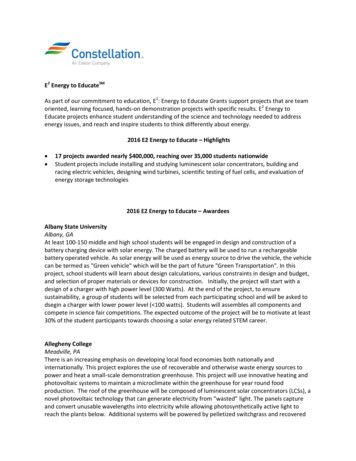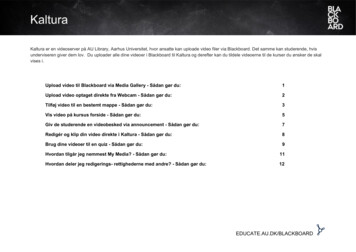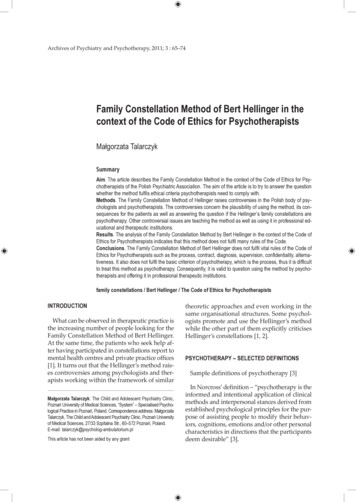
Transcription
E2 Energy to EducateSMAs part of our commitment to education, E2: Energy to Educate Grants support projects that are teamoriented, learning focused, hands-on demonstration projects with specific results. E2 Energy toEducate projects enhance student understanding of the science and technology needed to addressenergy issues, and reach and inspire students to think differently about energy.2016 E2 Energy to Educate – Highlights 17 projects awarded nearly 400,000, reaching over 35,000 students nationwideStudent projects include installing and studying luminescent solar concentrators, building andracing electric vehicles, designing wind turbines, scientific testing of fuel cells, and evaluation ofenergy storage technologies2016 E2 Energy to Educate – AwardeesAlbany State UniversityAlbany, GAAt least 100-150 middle and high school students will be engaged in design and construction of abattery charging device with solar energy. The charged battery will be used to run a rechargeablebattery operated vehicle. As solar energy will be used as energy source to drive the vehicle, the vehiclecan be termed as "Green vehicle" which will be the part of future "Green Transportation". In thisproject, school students will learn about design calculations, various constraints in design and budget,and selection of proper materials or devices for construction. Initially, the project will start with adesign of a charger with high power level (300 Watts). At the end of the project, to ensuresustainability, a group of students will be selected from each participating school and will be asked todsegin a charger with lower power level ( 100 watts). Students will assembles all components andcompete in science fair competitions. The expected outcome of the project will be to motivate at least30% of the student participants towards choosing a solar energy related STEM career.Allegheny CollegeMeadville, PAThere is an increasing emphasis on developing local food economies both nationally andinternationally. This project explores the use of recoverable and otherwise waste energy sources topower and heat a small-scale demonstration greenhouse. This project will use innovative heating andphotovoltaic systems to maintain a microclimate within the greenhouse for year round foodproduction. The roof of the greenhouse will be composed of luminescent solar concentrators (LCSs), anovel photovoltaic technology that can generate electricity from “wasted” light. The panels captureand convert unusable wavelengths into electricity while allowing photosynthetically active light toreach the plants below. Additional systems will be powered by pelletized switchgrass and recovered
oil. All systems will be monitored so that energy production and consumption can be assessed bystudents through established educational programs. Once the greenhouse has been fitted with thetechnologies to generate power and heat from recoverable and waste energy sources, it will be usedas a demonstration laboratory and educational tool to teach hundreds of students and serve as amodel for the potential application of these technologies elsewhere on or off campus.Carnegie Mellon UniversityPittsburgh, PAThe Carnegie Mellon Racing Team is a group of students that build 100% electric vehicles from theground up each academic year. Carnegie Mellon Racing promotes excellence in engineering as itencompasses all aspects of industry engineering including research, design, manufacturing, testing,developing, marketing, management and finances. Our Electric Race Car project takes students out ofthe classroom and allows them to apply textbook theories to real work experiences. The teamdevotes thousands of hours to designing the vehicle using industry-level system analysis and 3D CADsoftware, then physically builds it once the designs have been validated. Once the vehicle is completedthe team allocates time to testing and tuning the vehicle to collect data and see where improvementscould be made. The team then participates in two competitions at Formula Hybrid in April and FSAEElectric in June. At these competitions the team competes in events against teams from both theUnited States and Europe.Challenger Center for Space Science EducationWashington, DCChallenger Center will create an 8-hour program that introduces early high school students to energyscience and careers. The program will include an overview of energy science, including topics relevantto the energy in Transportation, Backyard Generation, and Zero Waste focal areas. The program willalso include a hands-on, team-based research challenge, an introduction to energy careers, and anopportunity to interact with energy professionals. In 2017, Challenger Center will design and pilot thisprogram with at least 100 students in Washington, DC. Then, we will share this program with ournetwork of 43 Challenger Learning Centers in the U.S. and internationally, who deliver high qualitySTEM programming to more than 250,000 students annually. We also have over 20 communitiesactively working to establish a Challenger Learning Center that are seeking programs like this toengage students and teachers during the multi-year process of opening a Center.Coppin State UniversityBaltimore, MDThere has been an exponential growth in the generation of renewable energy from sources such asWind and Sun. However, production of energy from these unconventional sources is not continuous:The wind does not blow and the sun does not shine all the time at particular place. The use of energystorage and charge devices is therefore paramount for renewable energy applications such as intransportation. Two hundred forty (240) students form Blueford Jamison STEM Academy (BDJ), CarverVocational Technical High School, Al-Rahmah High School (ARH) and Coppin Academy High School willbe coached by ten faculty, one post-doctoral researcher, one research technician and 30 students atthe Coppin State University (CSU) Natural Sciences and Center for Nanotechnology on energy storageand charging system technologies and how they can be utilized in an environmentally friendly solarlight rail. Students will receive hands on training and become acquainted with the energy storage,
rapid charging devices and the construction of a makeshift solar light rail. The above mentionedfaculty, staff and students will mentor students as undertake projects and explore careeropportunities in renewable energy technologies.East Carolina UniversityGreenville, NCThis project will educate and inspire students on the significance and societal benefits of sustainabilityand renewable energy in the preservation of environment and natural resources through a hands-onsolar technology project. Approximately 150 East Carolina University Students from the College ofEngineering and Technology (CET) will partner with Lucille W. Gorham Intergenerational CommunityCenter (IGCC) to develop and deploy renewable energy sustainable systems with a goal to build a netzero energy facility.Joliet Junior College FoundationJoilet, ILGirls Leading the Charge will provide 250 minority and under-represented female students from lowincome middle schools an opportunity to learn about energy, specifically solar powered cars, bybecoming a design engineer. Joliet Junior College's (JJC) solar-powered car program is a valuableSTEM hands-on learning experience. Students will learn principles of basic physics, mechanics, andsolar energy while also developing critical thinking and problem-solving skills. The free course will beheld afterschool in the spring and fall, and during the summer. The highpoint of the Girls Leading theCharge project will be the building of the commercially available solar-powered car instructional kits.Using the kits, students will work in teams to design solar-powered cars, learn aboutsolar/photovoltaic (PV) cells, troubleshoot, and prepare to test their car's functionality. As part of thelearning process, the students will be able to experiment with gear drive and pulley drive systems todetermine which produces the fastest solar car. In addition, students will test different solar cellpositions to determine which is most effective. Even though the students will be learning through theuse of a kit, it will provide flexibility and creativity for them to build and test their own design. As afinal project, the students will share their experience with the design process with each other andlocal business and technology professionals, and ultimately race their cars to determine the mostsuccessful design.Kean UniversityUnion, NJThe project will provide workshops where 310 high school students and 20 high school educators willlearn about basics, application, and impacts of renewable energy through hands-on activities andsoftware tools. Four workshops will be provided: Solar panel workshop Fuel cell workshop Home energy use workshop Life cycleAll workshops and activities will be offered during the week of Earth Day 2017, in order to celebratethe Earth Day and promote sustainability study in high schools. The project is also expected toincrease the amount of students majoring in Sustainability Science at colleges and universities.
Klein Independent School DistrictSpring, TXThis project will provide solar energy panels and components for a mobile classroom that supportsover 20,000 students throughout the district. and 12,000 additional community members each year.The panels will be placed on top of the trailer, and wired for proper energy storage and distribution.The purpose of the mobile classroom is to promote STEM careers. The trainer of the classroom willshow students how solar energy can be used to support the energy needs of basic things inside a car,home, or commercial building. The second part of this project will provide learning kits that containmaterials for hands on energy-based lab experiments. Students will research the advantages anddisadvantages of different forms of energy. Students will discover the impact of energy sources onsociety and the environment. Students will discover the practical applications and value of alternativeenergy sources in transportation, home, and commercial use. Approximately 10,000 thousandstudents in Elementary, Intermediate and High Schools will benefit from these experiments each year.Twelve kits will be purchased along with twelve hydrogen fuel cell refilling stations. The kits will beshared with 44 schools in our district. The kits target specific standards in the Texas curriculum thatwill benefit students at all levels.Mid-State Technical College FoundationWisconsin Rapids, WIProject "Distributed Education: Power to the People" seeks to bring renewable energy training directlyto the community through a shared mobile renewable energy classroom and education platform. Thisgrant emphasizes equal access to renewable energy equipment; solar for all.This project will meet the following objectives. Make renewable energy education accessible. Provide classroom hands-on tools and curriculum to provide a greater understanding of energyproduction and distribution Inspire students to consider careers within the renewable energy industry Provide incentive for 10 students to enroll in the MSTC Renewable Energy program Reach 10% of regional high school and middle school students and inspire their intellectual scientificcuriosity in energy technologyNueva Esperanza Academy Charter SchoolPhiladelphia, PAEsperanza Academy Charter School, which serves 1,400 predominately low-income Latino students inNorth Philadelphia, will offer 7th- and 8th-grade science and engineering classes a unique opportunityto experiment with the energy infrastructure of the future. Students will work in teams to buildmodel alternative-energy vehicles and to test the efficiency of their designs. They also will develop thecharging infrastructure to fuel their vehicles and will compare the effectiveness of various energystorage methods. Finally, students will consider how their experimental systems might contribute tothe construction of a more reliable energy grid. Our primary goal for the 21st Century EnergyInnovation Lab program is to get low-income Latino middle school students excited about STEM fields,where Latinos are currently only 2% of the workforce nationally.
Penn State Wind Energy ClubUniversity Park, PAPenn State's Wind Energy Club is motivated to inspire secondary school students to pursue STEM andrenewable energy careers while also teaching them about the energy that is present in their ownbackyards and being renewed on a daily basis. They propose to construct an interactive, portable windturbine to encourage high school students to learn more about wind energy while also exploring novelscience, engineering and math concepts! With the help of the E2 Energy to Educate Grant, PennState's Wind Energy Club will be designing, testing, and manufacturing a portable wind turbinedesigned to educate secondary school students on the power in the wind available in their own schoolyard. The previous experiences the team has with designing and building a fully operational windturbine for the Department of Energy Collegiate Wind Competition will be brought to bear into thedesign of the current system. The proposed project has two components: the development of theturbine itself and the design of interactive, educational activities for secondary school students toparticipate in.Rochester Institute of TechnologyRochester, NYRIT's K-12 Education for Electricity Generation Using Fuel Cells program is designed to take what weknow about the importance of alternative and clean energy resources, and make that knowledge apart of curriculum. This program has two goals: 1.) To conduct workshops for high school teachersthat address how to bring issues of global warming, the need for clean energy, and the changingtechnology of fuel cells to their classrooms.2.) To conduct a summer program for students in grades 7-12 to expose them to new technology inenergy, allow them to conduct experiments in this field, and to increase their overall knowledge ofand interest in alternative clean energies. The program consists of teacher workshops and studentsummer programs that include lectures, hands-on experiments, and laboratory tours all devoted tosubjects like solar power, hydrogen fuel cells, environmental sustainability, and how all of this isimproved through the study of the various sciences.Solar OneNew York, NYSolar One's Green Design Lab (GDL) program is an award-winning K-12 environmental educationprogram and curriculum, developed in partnership with the NYC Department of Education (NYC DOE),and is the only curricular blueprint of its kind that utilizes the school building as both a laboratory forlearning and a tool for environmental change. As part of our Green Design Lab programming, SolarOne will deliver a "backyard generation" unit, over 6 weeks, to 6 classes at the East Village CommunitySchool. Up to 25 students will be in each class, and thus the program will reach 150 students. Thelessons and activities will focus on energy, PV solar and battery storage. During the 2015-2016 schoolyear, we reached 295 teachers and more than 200 students through the NYC Solar and NYS K-Solarprograms.Southern Illinois University East St Louis
East St Louis, ILStudents will participate in weekly hands-on project-based units designed to increase critical thinkingskills, build their interest in energy careers, and teach them team work and the thrill of cooperativecompetitive. The program will be implemented using an evidence-based renewable energy curriculumdeveloped by the SIUE STEM Center supplemented by guest speakers and workplace learningopportunities with the National Corn-to-Ethanol Research Center (NCERC) at SIUE. East St. Louis ZeroWaste Challenge will target middle and high school students from SIUE's Upward Bound Program.Upward Bound serves low-income first generation college students from Greater East St. Louis regionschool districts (East St. Louis District 189, Brooklyn United District 188, and Cahokia Unified SchoolDistrict 187, East St. Louis Charter High School and Madison School District). The project targets acommunity that is severely disadvantaged in STEM, with the goal of narrowing the achievement gapand providing enhanced opportunities in STEM for minority students. The project will enhance ourscience, technology, engineering and math (STEM) programming with an energy education curriculumfor 825 middle and high school students, project based learning and a competition aimed ateliminated waste in East St. Louis.University of MarylandCollege Park, MDThe U.S. Department of Energy Solar Decathlon challenges collegiate teams to design, build andoperate solar-powered houses that are cost-effective, energy-efficient and attractive. The 2017 SolarDecathlon will take place October 5th through 15th, 2017, in Denver, Colorado. Teams are challengedto demonstrate the best blend of affordability, consumer appeal, and design excellence with optimalenergy production and maximum efficiency. An anticipated 90,000 visitors will attend thecompetition, providing high visibility as teams showcase the most innovative and cutting edge inenergy-efficient, sustainable technology. University of Maryland College Park's last entry, in 2011, wasawarded first place.University of PittsburghPittsburgh, PAOver 700 students from Pittsburgh's universities (University of Pittsburgh, Robert Morris University),local schools and summer programs will be engaged in an innovative hands-on Energy curriculum thatrevolves around teams of students designing and building energy technology prototypes. Buildingupon successful outreach programs enabled by the Mascaro Center for Sustainable Innovation seedgrant, the curriculum will focus on student learning of fundamental science and engineering conceptsby synthesizing our energy curriculum around Energy "Inventor-labs". Student-teams will embark on a3-tiered Design-Build Energy challenge by inventing prototypes that demonstrate Energy Generation and Conversion (Tier 1) Increased Energy Efficiency (Tier 2) Sustainable Energy Technology (Tier 3)Upon completion of the 3-tiered challenge student teams then select an energy design problem oftheir choice. These final projects will culminate in a design expo in the Summer of 2015 and December2015 where student teams and prototypes from all schools and programs will be showcased andcelebrated at a public event at the universities. While two "teach the teacher" sessions will occur inthe summer as part of a continuing education program to reach an additional 500 students, theultimate goal is to catalyze the creation of a team-oriented, learning focused, hands-on spaces and
culture in our classrooms that will attract support and further the Energy to Educate goals long afterthe completion of the project. An essential element is that the rapid prototyping and physicalmodeling of energy technologies will require students to practice high-level thinking (e.g. analysis,synthesis, evaluation) while building a culture geared toward Energy tech innovation.
Nueva Esperanza Academy Charter School Philadelphia, PA Esperanza Academy Charter School, which serves 1,400 predominately low-income Latino students in North Philadelphia, will offer 7th- and 8th-grade science and engineering classes a unique opportunity to











